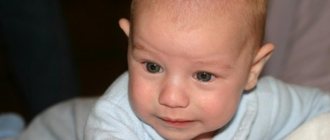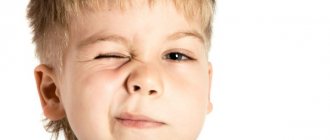Development of perception in children from birth to one year: first knowledge of the world
From the first day of life, a child is surrounded by all kinds of sounds, smells, people and objects. However, during the first few weeks the baby only senses some properties of reality. With the help of perception, a child learns about the world that surrounds him and accumulates knowledge about him and himself. Therefore, perception is a basic and important function in infants. Visual perception is the basis of visual memory, thinking and attention. For successful speech acquisition, auditory perception plays an important role. Developed spatial perception will help the child develop adequate self-esteem and give self-confidence.
Child from one to 2 years old: perception of space and content
During this period, the child actively gets acquainted with space, since by this time he already begins to walk. Although the characteristics of objects in space still merge with their content. And starting from 1 year 2 months, a child is able to find an object by word if he has a connection between this word and the object. For example: “Give me a cube.” And by about 1 year 8 months, many words acquire a general meaning. Thus, children begin to attribute a particular word to several objects with different characteristics, and not to just one. The child is already able to distinguish a toy that is new to him and sort objects not only by color and shape, but also by more complex characteristics, for example, separating dog toys from cats. But to correctly select an object based on a word, the child still needs up to 8 repetitions.
How children learn about the world around them
Familiarizing a child with the outside world and social reality is a complex and pressing problem. How to introduce children to the world around them? What attitude should a small child develop towards him? What ideas about the world should I introduce? What does a child need to know from the huge amount of information about the world around him?
The most important features of preschool children’s perception of the world around them are observation and emotionality. Children notice a lot: the structural features of objects, animals, their behavior, the mood of people. They first feel the world, and then realize it, and often emotional assessments are ahead of true, objectively existing ones.
He can trust your knowledge, rely on his personal experience, get information from books, and go through experiments. It is important that the child has his own insights and “eureka” moments as often as possible.
Everyone has heard about the sixth sense - intuition. All children are intuitive, because they live by feelings, and not by their minds (for now). Have you noticed how accurately they define the essence of a person? How truthful and accurate are they in their assessments? You cannot deceive them with kind words. They believe their hearts, not adult, confusing meanings.
The broader a child’s horizons, the easier it will be for him to go through life. Every adult's vision of the world begins in early childhood. Over time, it changes, improves, becomes more complex (or vice versa, simplifies). Our type of thinking and worldview largely depends on the environment in which we grew up and the influence our parents had on us. We need to remember this when we ourselves become parents... The most important thing is that they are an inviolable authority for their baby. They are also the main role models. It is for this reason that children often copy and subsequently reproduce the behavior, manners and speech of their parents. For the most part, this happens on a subconscious level. What they see is imprinted in their memory and serves as a kind of behavioral template.
How the child and the world around him will interact largely depends on the family. If there is a calm, peaceful environment at home, love and mutual respect reign around, this will become the norm for the child. Conversely, a child’s rude behavior in a group is the result of a tense environment at home.
Society, of course, is an integral part of the surrounding world. Adapting to society, children get used to the fact that they are surrounded by other individuals who must be taken into account. Adaptation of children in society occurs in three stages:
1. Games with children on the street. This introduction to the outside world occurs at a very early age, when mothers take their babies for a walk. As a rule, there the child gets to know his peers, the same kids, and learns to communicate with them, play, and develop interaction skills.
2. Preschool institutions. At this stage of social adaptation, the child’s world around him changes. His mother, who used to accompany him everywhere, is no longer with him. The child learns to independently resolve difficulties and conflict situations.
3. School. This stage prepares the growing person to enter adult, independent life.
Nature and watching animals can teach a little person a lot. This is one of the most important ways to get to know the world around you. Therefore, children need to be taken out for walks more often, taught to observe natural phenomena, admire them, and talk about what they saw together.
It is also important to teach children to take care of nature and its riches. The youngest children can be told that everything that surrounds them is alive, so flowers, trees, and animals should not be offended.
A child and the world around them can become friends, or they can become enemies for life. It is very important to help a little person become a harmonious part of the world around him. Therefore, of course, it is necessary to work on the child’s horizons - and work constantly. But the information provided to the baby must correspond to his ability to understand; Perhaps this information should only slightly outstrip the capabilities of his intellect. The unknown seems mysterious to the child, the mysterious captivates and forces the intellect to work more actively; By working, the intellect develops.
The world of animals and plants is closest to the understanding of a child of primary preschool age. And this is no coincidence. Our ancestors were part of nature, they were surrounded by a variety of animals and plants; and food and clothing - everything was given to them by the close natural environment (however, residents of rural areas are still close to nature, unlike city dwellers), and to a modern child, on a subconscious level, the world of animals and plants seems the most harmonious and understandable in its own way.
You should begin to develop your child’s horizons with a more careful acquaintance with the world of animals and plants. It is clear that cinema, television, and home video are of considerable importance in this matter, and their capabilities should certainly be used. However, the impressions from direct communication with animals and plants are a hundred times stronger, which means that the practical benefits of such communication will be greater.
In this regard, it is recommended, as often as possible, to arrange excursions for the child to the zoo, to various animal exhibitions - including exotic ones (for example, reptiles), to attend pet competitions (cats, dogs, songbirds, etc.); Even an ordinary visit to a pet store, the walls of which are lined with cages, or even spacious vivariums, the window sills with aquariums, is an event of events for a child. In absentia, the child is familiar with many of the animals from his mother’s fairy tales, pictures, cartoons and educational television programs; meeting animals that are real to him is a real holiday!
It is very exciting and useful for the baby to get acquainted with the world of plants. Walking with your grandmother in the garden, with your grandfather in the garden, going out with your mother into a field full of a variety of herbs and flowers, smelling the smell of field plants, hearing the chirping of grasshoppers in the grass and the songs of birds, the sound of the wind in the leaves - the best for a child of four or five years old pastime; he will use vivid impressions, the simplest knowledge gained from such walks throughout his life, since the impressions received afterwards will no longer be so vivid, and the knowledge acquired at an older age will not be so exciting... If the family lives in a big city , you need to visit squares and parks with your child more often, the botanical garden, all kinds of exhibitions - flowers, cacti, fruits, etc.
There is no doubt that a four- to five-year-old child will already understand, and therefore be interested in, the exhibition of a local history museum. Collecting a home herbarium will be a very exciting activity for a child, and the child will probably, with bated breath, begin to straighten the flowers and leaves, covering the plant laid out on cardboard with thin paper and watching how the elders place the resulting strange object under the press. You can decorate a child’s room with collected and successfully dried plants, placing them in frames under glass, and if the child takes part in this, he will be incredibly pleased and proud.
The mother should actively work on the child’s horizons - not only show him animals and plants, but also talk about them, tell him what she knows; For a child of this age, a minimum of knowledge is enough: where animals live, what they eat, how they raise their young; what the plants are called, what benefits they can bring to humans (decorative, medicinal, edible, etc.).
If the mother and other household members regularly and tirelessly work with the baby and work on his horizons, then at the age of four or five he will easily distinguish a wolf from a dog, a goat from a sheep, an owl from a quail, a stork from a crane, a chamomile from a calendula, an apple tree from a pear , coltsfoot from plantain. And he will need it in life.
Period from 2 to 3 years: formation of lasting connections
By this age, the child has accumulated certain experience, it is already easier for him to recognize and distinguish between the objects that surround him. The connection between word and object is established much faster. From the age of two, children need only 4 repetitions to select an object by name. And the older the child gets, the more stable connections are formed between words and the differentiation of objects. Thus, as a result of observations, it was found that by preschool age, children, perceiving unfamiliar objects, are independently able to find their names by similarity to a symbolic object, for example, an oval - lemon, egg.
By the end of two years of age, a child is able to correctly name an object familiar to him, however, when identifying certain features, he may ignore individual details and make mistakes, for example, calling a tiger cub a cat and, generalizing objects based on various random features, calling them one word.
Development of perception in 3-year-old children
Children already perceive pictures with a simple plot and can name each object in the image. For example, a boy, a flower, a car, etc. However, children begin to perceive functional connections (person-action) only towards the end of the preschool period.
By the age of 3, a child can perceive colorless and contoured objects that are familiar to him. They perceive pictures with various objects well, so they are able to choose the right pair in the lotto game. However, unfamiliar objects are perceived only by recognizable features and secondary characteristics, so they can make mistakes.
Unfortunately, many scientists argue about whether sensations and perceptions are innate or socially conditioned. Some believe that a child already knows a lot about the world in the womb. Others point out the importance of a child's activity as it affects his development. Although any child requires only attention and care, any parent can influence the activity of their baby.
Read: 5,049
A little about perception
Due to the nature of my work, I often visited various early development centers and schools (I brought pupils there for classes) and observed the same picture almost everywhere. The teacher starts the class, turns on the music (song) and encourages the kids to dance. She makes certain movements and asks you to repeat them after her. Some of the children are trying to copy. Others simply dance to the beat of the music, not paying attention to the teacher. But there were always one or two kids who simply stood, huddled close to their mother, and watched the action. Or even (whoever is smarter and more independent) went to explore the study room, completely ignoring the teacher’s call and the mother’s entreaties to join in the general fun. Well, it’s not interesting for a baby to dance!
And so the whole lesson. Assignments change, the activity of children interested (or not interested) in this or that action changes. And the point is not whether the baby is shy or sociable, active or calm. After all, without wanting to dance or jump to the music, he quite quickly and accurately completes tasks associated with magnetic boards, cards, and drawings. Or he finds it easy to do tasks related to construction or fine motor skills.
For parents whose children behave this way, this is your first warning sign. Pay attention not to the child’s character (even if the baby is calm, he will quite like to move to the music), but to his preferences in games and activities.
In theory it sounds like this...
Psychologists have long divided all people into three main categories:
- auditory learners - those who perceive and assimilate information well by hearing;
- kinesthetics - perceiving the surrounding reality through taste and tactile sensations;
- visual people - whose leading organ of perception is vision.
There are also so-called discretes (who have a logical perception of information), but there are very few of them among adults, and almost none at all among preschool children.
The ability to better perceive information with one or another organ is given to us from birth. But this does not mean that there are pure (by nature) visuals, pure auditories or pure kinesthetics in the world (all psychologists will tell you the same thing). It’s just that some feature of human perception is more developed than others.
I will say a banality known to everyone. The baby begins to hear sounds even before birth. Feel (tactilely) - immediately after birth. But vision, although it develops gradually (during the first year), plays an even greater role in our subsequent lives than sensations.
Speaking in theory, visual kids:
- love to watch bright, colored pictures, cartoons;
- observe the actions of other people, work, play, animal behavior, natural phenomena;
- they themselves rarely take part in outdoor group games;
- when communicating with familiar people, always look into the face and often into the eyes;
- When expressing emotions or talking about their feelings, they use terms associated with color or inactive action.
Auditory children:
- they adore everything related to music and sounds (screaming, squeaking, musical toys);
- love to listen to audio fairy tales or simply have them read aloud, easily remembering the plot;
- very emotional when talking about something and often use words associated with movement;
- They don’t really like visual or tactile contact and when communicating even with family they often look away.
It is common for kinesthetic children to:
- communicate and express emotions through touch;
- choose active games and activities related to construction;
- When describing your feelings, often use words meaning movement and feeling.











